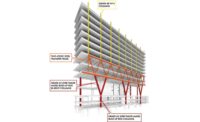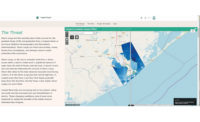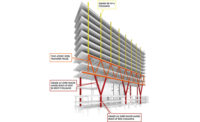The site of the former Phoenix Ironworks Steel Factory in West Oakland, Calif., has sat empty for 35 years even as a housing crisis has gripped the area and led to accidents such as the Ghost Ship warehouse fire in 2016. But the five-acre slab of concrete will soon become new housing thanks to an effort from Autodesk, Kreysler & Associates, Factory_OS and MBH Architects.
Developers of The Phoenix plan to have 316 affordable units. Partial funding comes from the California Housing Accelerator and Local Housing Trust Fund Program, which provides incentives for affordable housing projects that can achieve tight timelines impossible with traditional design and construction methods. To meet both its sustainability goals and the tight timelines for unlocking state funds, the team building The Phoenix had to turn to prefabrication and alternative materials.
The units have fiber-reinfcorced composite polymer (FRP) facade panels that have an insulative interior of mycelium, the roots of mushrooms. MBH Architects also used the Autodesk Forma conceptual cloud tool to make design decisions, such as moving greenspaces so that they will be more accessible, adding floors and changing individual building heights to gauge how it impacts sustainability. Revit was used for detailed design.
The 36-ft-long FRP facade panels were developed and are being fabricated by Kreysler & Associates, a facade consultant in American Canyon, Calif. The mycelium biomaterial is being formed and “baked” into shapes that fit into the panels by Ecovative, a sustainable products company from Green Island, NY. The mycelium inserts sequester more carbon dioxide than is emitted by the entire production of the panel due to the volume of plant-based material. The mycelium and the specific properties it was grown with allows the panels to achieve fire resistance, acoustic, thermal and energy absorption ratings.
Factory_OS is a modular builder that Autodesk has invested in and which builds full apartments—two-bedroom and one-bedroom units—onsite in its Vallejo, Calif. factory. Factory_OS and Kreysler are both using Autodesk’s Design and Make platform to coordinate production and plan deliveries.

The mycelium fill of the Phoenix panels has insulative and acoustic properties.
Photo by Jeff Yoders/ENR
MBH and Factory_OS have developed more than 25 different modular apartment variations that can be stacked like LEGO in several ways for better building orientation or different functions. The team hopes to begin placing them on the West Oakland site by spring, pending approvals, and have the project completed by 2025.
“I think most people agree that work on the job site is difficult to do efficiently and correctly, unless it’s assembling manufactured products,” says William Kreysler, president of Kreysler & Associates, which has created composite materials for use in art, architecture, and industrial applications for 40 years. The goal of getting buildings built quickly and more sustainably using these methods appeals to him, he adds.
“For a facade, conventionally you hire a contractor, build a scaffolding, get a stack of Trespa panels out there and a bunch of aluminum extrusions and start putting up a facade on this scaffolding assembly,” he says.
It’s a long process. Kreysler said incentives will help bring systems such as The Phoenix into use. “There has to be an incentive, whether that’s in the state of California or elsewhere, that’s a real driver for trying to get buildings built quickly.”






Post a comment to this article
Report Abusive Comment